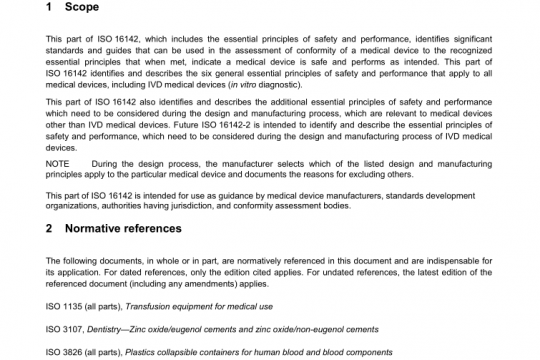AAMI ISO 23500-1 pdf free download
AAMI ISO 23500-1 pdf free download.Preparation and quality management of fuids for haemodialysis and related therapies—Part 1: General requirements.
4 Quality requirements 4.1 General The quality requirements set forth in respect of dialysis water (4.2), concentrates (4.3), and dialysis fluid (4.4) are identical to those in ISO 23500-4, ISO 23500-3, and ISO 23500-5. The latest editions of these documents should be consulted to ascertain if there have been any changes to quality requirements before implementing the recommendations of this document. 4.2 Dialysis water 4.2.1 General The requirements contained in this clause apply to dialysis water at its point of use. As such, these requirements apply to the water treatment system as a whole and not to each of the devices that make up the system. However, collectively, the individual devices shall produce water that, at a minimum, meets the requirements of this clause. 4.2.2 Chemical contaminants in dialysis water Dialysis water shall not contain substances at levels greater than those listed in Tables 1 and 2. The manufacturer or supplier of a complete water treatment system should recommend a system that is capable of meeting these requirements based on a feed water analysis. The system design should reflect possible seasonal variations in feed- water quality. The manufacturer or supplier of a complete water treatment and distribution system should demonstrate that the complete water treatment, storage, and distribution system is capable of meeting the requirements of ISO 23500-3 at the time of installation. NOTE The maximum allowable levels of contaminants listed in Tables 1 and 2 include the anticipated uncertainty associated with the analytical methodologies listed in Table 4 of ISO 23500-3:2019. Other analytical methods can be used, provided that such methods have been appropriately validated and are comparable to the cited methods. Following installation of a water treatment, storage, and distribution system, the user is responsible for regular surveillance of the levels of chemical contaminants in the dialysis water and for complying with the requirements of this document.4.2.3 Organic Carbon, pesticides and other chemicals The presence of organic compounds, such as pesticides, polycyclic aromatic hydrocarbons and other chemicals such as pharmaceutical products and endocrine disruptors in respect of hemodialysis patients are difficult to define. Consequences of exposure are probably of a long-term nature and it is technically difficult and costly to measure these substances on a routine basis. Furthermore, there is an absence of evidence of their widespread presence in water although it is recognized that inadvertent discharges are possible. In view of this, It is not at present possible to define limits for their presence in water used in the preparation of dialysis fluid. Nanofiltration and reverse osmosis are capable of significant rejection of many such compounds. Granular Activated Carbon (GAC) is also highly effective at removing the majority of these chemicals. However, as Granular Activated Carbon is widely used in the removal chlorine/chloramine, their use in the removal or organic carbons, pesticides and other chemicals will be dependent upon the size of the carbon filters and/or beds and users shall be aware of appropriate dimensioning since the majority of carbon valences might be already occupied and not available for further removal activity. 4.2.4 Microbiological contaminants in dialysis water The total viable microbial count and endotoxin concentration in dialysis water shall comply with the maximum allowable levels specified Table 3. Action levels for the total viable microbial count and endotoxin concentration shall also be set, based on knowledge of the microbial dynamics of the system. Typically, the action level is set at 50 % of the maximum allowable level for bacteria and endotoxins. If a total viable microbial count or endotoxin concentration at or above the action level is observed in the dialysis water, corrective measures should be taken promptly to reduce the level. AAMI ISO 23500-1 pdf download.
Other IEC Standards
-

ANSI AAMI ISO 16142-1 pdf free download – non-IVD medical devices and guidance on the selection of standards
AAMI standards list DOWNLOAD -

ANSI AAMI ISO 16142-2 pdf free download – General essential principles and additional specifc essential principles
AAMI standards list DOWNLOAD


